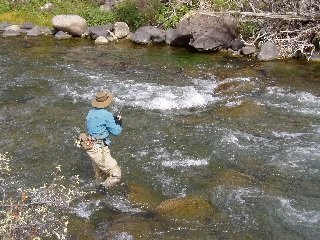 Tackling rough water can be hard for even an experienced fly angler, let alone newcomers. Fast water and swift current can be very difficult to judge, and even more difficult to manage with a floating fly line. Furthermore, trout can be very selective in rough water conditions, which makes getting a drag-free drift on your fly presentation crucial. For this reason, understanding how casting distance, line color, and high sticking affect your presentation will mean more solid hook sets, and today we’ll take a look at how.
Tackling rough water can be hard for even an experienced fly angler, let alone newcomers. Fast water and swift current can be very difficult to judge, and even more difficult to manage with a floating fly line. Furthermore, trout can be very selective in rough water conditions, which makes getting a drag-free drift on your fly presentation crucial. For this reason, understanding how casting distance, line color, and high sticking affect your presentation will mean more solid hook sets, and today we’ll take a look at how.
Don’t Cast Too Far
The artful practice of fly casting is a common attraction for those interested in getting into fly fishing, but in rough water conditions, you’ll need to be mindful of how much line you have out. The more line you have out, the harder it will be for you to control both the line and your fly’s drift. With fast currents, though, fish tend to be less easily spooked because of the stirred up water and low visibility, so getting close won’t be an issue.
Consider Your Line Color
In rough water conditions every advantage you can gain in seeing your line on the water will be welcome. The faster you can find your line, the faster you can start the mending process and get your fly drifting as naturally as possible. Many anglers stick with fluorescent greens and oranges because they show up best in rough water and low light conditions.
High-Sticking is Key
High-sticking involves holding your fly rod high above your head and keeping the line taught and off the water, and it’s one of the only ways to get a long, drag-free drift from your fly line. Cast upstream or across from your target and lift the line off the water as soon as the fly lands. With the line off the water, you’ll have hardly any drag on the leader, so your fly will be able to sink and drift naturally, making it easy prey in rough waters, where fish tend to use the conditions for ambushing.
Rough waters can make managing your fly line a bit difficult, but mastering a few of techniques outlined today will make it a lot easier. Take time to practice these techniques in a variety of conditions and you’ll be rewarded with better results on the water.








